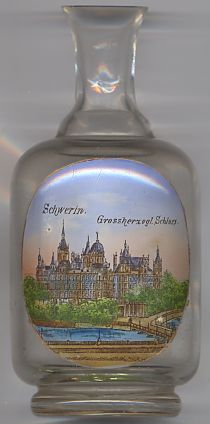

|
| DEUTSCHLAND | GERMANY |
| Bundesland: Mecklenburg-Vorpommern | Mecklenburg-West Pomerania |
| Stadt: Schwerin |
 Schwerin is situated at an elevation of 40 m on the southwestern shore of the lake, Schweriner See, amidst a beautiful lake and forest region.
Schwerin is the capital of the state of Mecklenburg-Vorpommern and has a population of about 97,000 (2005). It is thus the smallest of all the German
state capitals.
Schwerin is situated at an elevation of 40 m on the southwestern shore of the lake, Schweriner See, amidst a beautiful lake and forest region.
Schwerin is the capital of the state of Mecklenburg-Vorpommern and has a population of about 97,000 (2005). It is thus the smallest of all the German
state capitals.
The oldest written mentions of Schwerin are found in documents of 1012/1018 (Zuarina) and 1170 (Zuerin, Zwerin). The origin of the name is either explained as being derived from the Polabian word zvěŕ, i.e. 'wild animal', or as relating to the name of an ancient Slavic god, Svarog. The German town was founded in 1160 by duke Heinrich the Lion of Saxony and Bavaria. In 1167 the town became the seat of a county which, after the death of the last member of the family fell to the princes of Mecklenburg. After the partition of Mecklenburg in 1229/1238, Schwerin became the residence of the Mecklenburg-Schwerin (1348 duchy, 1815 grand duchy). Only between 1763 and 1837 the residence was located at Ludwigslust. In 1918 Schwerin became the capital of the Free State of Mecklenburg-Schwerin. In 1934 Mecklenburg-Schwerin and Mecklenburg-Strelitz were merged into the state of Mecklenburg. After World War II, the western part of Pomerania was incorporated into the state. In 1952 the state was dissolved and Schwerin became the capital of the district of the same name. After the re-unification of Germany in 1990 the state was re-established under the name Mecklenburg-Vorpommern.
 Schwerin castle is located on a small island in the lake. The earliest reports about a stronghold in this place date from 973 AD.
After its destruction in the 12th century it was rebuilt. Throughout the following centuries the castle was enlarged to meet the demands of a residence castle.
Parts of the castle date from the Gothic and Renaissance periods. When the court in 1837 moved back to Schwerin from Ludwigslust, the condition of the castle had
deteriorated considerably. It was determined to replace it by a new residence. Only four buildings from the 15th and 16th centuries on the lake front were spared.
Designs by Gottfried Semper and Friedrich August Stüler were not accepted by the grand duke, and finally Georg Adolph Demmler was chosen as architect. Demmler
found inspiration in French Renaissance castles but also included elements of Semper's and Stüler's plans. Demmler supervised the construction from
1843 until 1851, but was then laid off because of his commitment to support the democratic movement. He was replaced by Stüler who slightly altered the design of
the façade and also introduced the monumental cupola. The castle was finally completed in 1857. About one third of the castle was destroyed by a large fire in 1913.
The restoration of the castle took until 1918, but in the same year Grand Duke Friedrich Franz IV was forced to abdicate and the castle came in possession of
the state. Parts of the castle were opened to the public as a museum. In 1948 it became the seat of the parliament of Mecklenburg. From 1952 until 1981
a school for kindergarten teachers used most parts of the castle. After extensive restoration works that already began in the 1970s, the castle again became
the seat of the parliament (Landtag) of Mecklenburg-Vorpommern in 1990.
Schwerin castle is located on a small island in the lake. The earliest reports about a stronghold in this place date from 973 AD.
After its destruction in the 12th century it was rebuilt. Throughout the following centuries the castle was enlarged to meet the demands of a residence castle.
Parts of the castle date from the Gothic and Renaissance periods. When the court in 1837 moved back to Schwerin from Ludwigslust, the condition of the castle had
deteriorated considerably. It was determined to replace it by a new residence. Only four buildings from the 15th and 16th centuries on the lake front were spared.
Designs by Gottfried Semper and Friedrich August Stüler were not accepted by the grand duke, and finally Georg Adolph Demmler was chosen as architect. Demmler
found inspiration in French Renaissance castles but also included elements of Semper's and Stüler's plans. Demmler supervised the construction from
1843 until 1851, but was then laid off because of his commitment to support the democratic movement. He was replaced by Stüler who slightly altered the design of
the façade and also introduced the monumental cupola. The castle was finally completed in 1857. About one third of the castle was destroyed by a large fire in 1913.
The restoration of the castle took until 1918, but in the same year Grand Duke Friedrich Franz IV was forced to abdicate and the castle came in possession of
the state. Parts of the castle were opened to the public as a museum. In 1948 it became the seat of the parliament of Mecklenburg. From 1952 until 1981
a school for kindergarten teachers used most parts of the castle. After extensive restoration works that already began in the 1970s, the castle again became
the seat of the parliament (Landtag) of Mecklenburg-Vorpommern in 1990.
Another place that was previously called Schwerin an der Warthe is
Skwierzyna in Poland.
![[scale]](lineal.jpg)